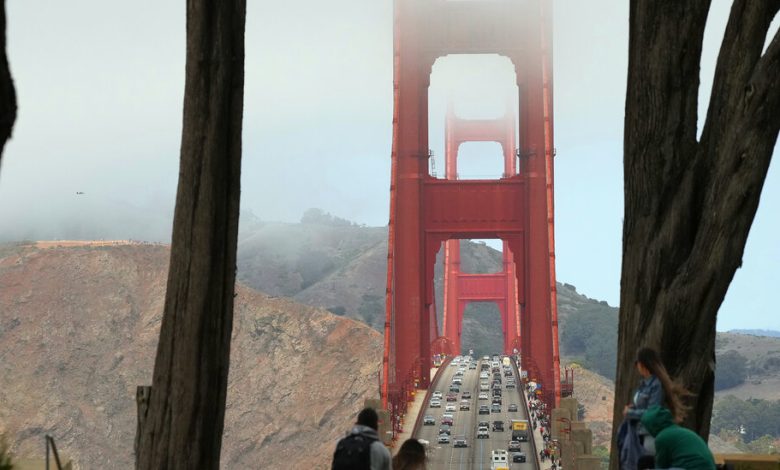San Francisco’s Brand Is in Trouble. Can a New Ad Campaign Fix It?

San Franciscans don’t like outsiders bashing their city, but they’re also cleareyed about its biggest problems: homelessness, rampant drug use and leaders who can’t seem to fix those issues.
So how does San Francisco turn its lackluster image around?
Some wealthy locals say the way forward is a brand refresh, and they are throwing their support behind a new $4 million ad campaign that will promote San Francisco as a hub of innovation and creativity.
The slogan? “It All Starts Here.”
It’s meant to remind San Franciscans — and everyone else — that the city of cable cars, Levi’s jeans, the Summer of Love, Gap Inc., Uber, Harvey Milk and the Golden State Warriors still has an exciting future ahead of it.
The campaign, funded by the tech billionaire Chris Larsen and Bob Fisher, whose parents founded Gap in San Francisco in the 1960s, includes a social media video narrated by the actor Peter Coyote, hundreds of billboards around the city, banners hanging from light poles, and bumper stickers and signs for business owners and residents to hang in their windows.
“No question we’ve got problems we’ve got to fix,” said Mr. Larsen, who has funded numerous start-ups and now sees his city’s reputation as desperately needing investment.
“But we can’t let the brand just suffer,” he added. “We’ve got so much to be proud of, and we can’t lose sight of that.”
The campaign will be announced on Thursday at Oracle Park, the home of the San Francisco Giants. While it has been mostly funded by Mr. Larsen and Mr. Fisher, the campaign is being orchestrated by Advance SF, a new organization made up of the city’s biggest employers, as an effort to bolster civic pride and lure tourists and convention-goers back.
San Francisco’s tourism industry is slowly returning, but it hasn’t fully recovered from the pandemic. In August, for example, data collected by the city tourism board showed that 69 percent of the city’s hotel rooms were occupied that month, compared with 85 percent during the same month in 2019.
“What we need to do is not let the self-fulfilling prophecies engulf us,” said Larry Baer, the Giants’ president and a co-chair of Advance SF. He noted that it was especially important to break out of the malaise as President Biden and other heads of state were scheduled to come to the city next month for the Asia-Pacific Economic Cooperation summit.
“This is a major pushback against a narrative we think is false,” Mr. Baer said.
Still, there’s no doubt that locals are down on their city. A poll of 458 San Francisco voters conducted last month by GrowSF, a moderate political advocacy group, found that 68 percent of respondents thought the city was on the wrong track.
At least 80 percent cited homelessness, open-air drug use and fentanyl dealing as very serious problems, and about two-thirds disapproved of the job that Mayor London Breed and the Board of Supervisors were doing.
The good news: 86 percent of respondents believe that the city’s problems can be fixed. But can a few catchy words on bumper stickers really help?
Well, maybe.
Consider New York City in the late 1970s. Crime in the city was surging, tourism was suffering, and a blackout in 1977 prompted widespread looting and arrests. The city was nearing bankruptcy, and President Gerald Ford was refusing to offer federal help.
So the state of New York hired a Madison Avenue advertising firm, Wells Rich Greene, to develop a campaign to draw back visitors. They teamed up with the graphic designer Milton Glaser, who used a red crayon on a piece of scrap paper to create the original “I Love NY” logo, with a red heart in place of the word “love.”
Of course, a logo emblazoned on untold numbers of T-shirts in Times Square can’t be credited with changing an entire city’s fate. But it did at least coincide with renewed civic pride, a revitalized tourism industry and an eventual economic recovery.
Stefan Gruber, the director of the Remaking Cities Institute at Carnegie Mellon University, pointed to “I Love NY” as perhaps the best example of an effort to rebrand a city.
“We still buy the T-shirts after so many years!” he said with a laugh. “But that’s just scratching the surface.”
What really helped turn New York around in the 1970s, he argued, was the creation of the Urban Homesteading Assistance Board, which turned thousands of derelict housing units into rehabilitated cooperative housing for low-income tenants and reinvigorated neighborhoods.
“We cannot fix cities’ problems by hiring advertising agencies,” Mr. Gruber said, noting that the real way to transform San Francisco is to build more affordable housing in a city with a widening wealth gap and find creative ways to enliven the hollowed-out downtown.
Mr. Fisher, the chairman of Gap, said that San Francisco hasn’t built enough housing over the past several decades and that it has wrapped itself in too much red tape to do so quickly.
Still, he said he was hopeful for a comeback.
“We love this place,” Mr. Fisher said. “I’m excited about the future.”





